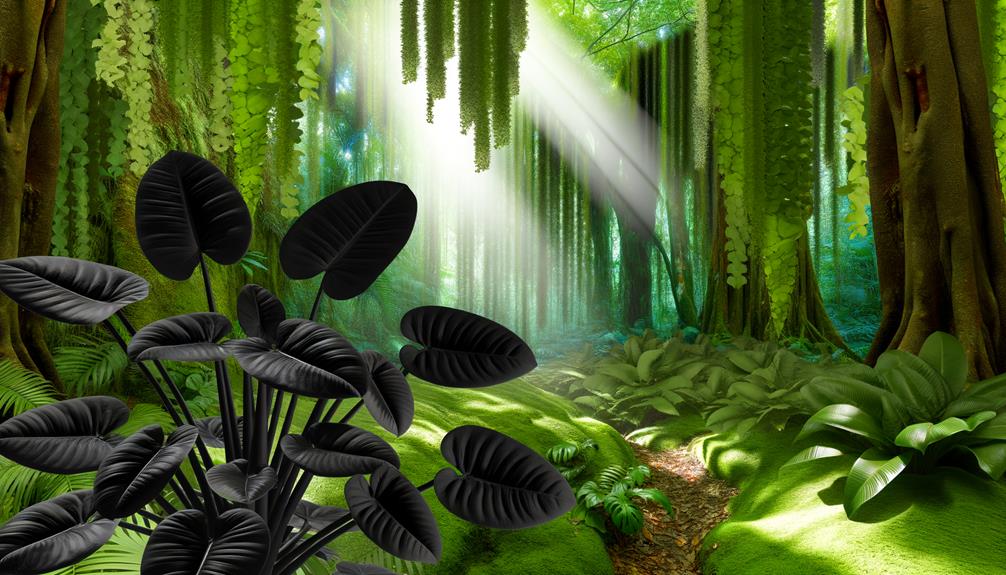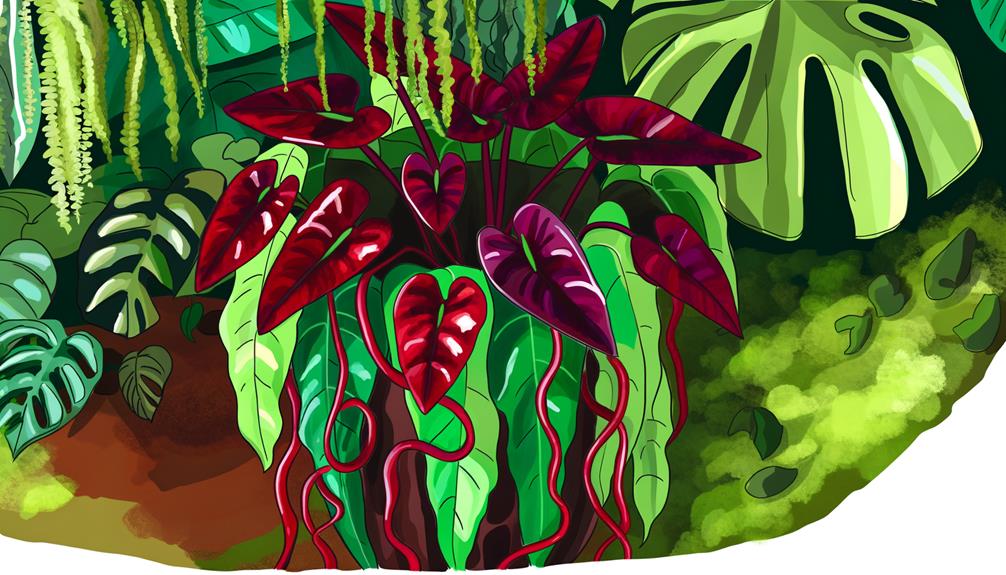What Hybrids Are Available for Philodendron Erubescens?
Philodendron erubescens offers several notable hybrids, each with distinct morphological traits. 'Black Cardinal' features deep burgundy to nearly black foliage and compact growth.
'Pink Princess' is renowned for its vibrant pink variegation. 'Red Emerald' boasts glossy, deep-red stems and cordate leaves.
'White Knight' has variegated foliage with a blend of green, white, and pink. 'Painted Lady' showcases a mosaic-like leaf pattern.
Other hybrids include 'Imperial Red,' 'Congo Rojo,' 'McColley's Finale,' and the striking 'Birkin.' Each hybrid thrives under specific conditions, offering unique aesthetic and botanical appeal to collectors and horticulturists alike. Discover more about their ideal cultivation requirements.

Key Takeaways
- Black Cardinal: Features deep burgundy to nearly black foliage with vibrant red stems and a compact growth habit.
- Pink Princess: Known for its striking variegation with pink splashes on dark green to burgundy leaves.
- Red Emerald: Displays glossy, deep-red stems and lush green, cordate leaves with pronounced venation.
- White Knight: Offers variegated foliage of dark green, white, and pink hues with heart-shaped, glossy leaves.
- Painted Lady: Distinctive leaf patterns with variegated, mosaic-like foliage requiring controlled humidity and bright, indirect light.
Black Cardinal

The Black Cardinal, a hybrid of Philodendron erubescens, is distinguished by its deep burgundy to nearly black foliage, which exhibits a striking contrast against its vibrant red stems. This hybrid is notable for its robust, leathery leaves that can reach up to 25-30 cm in length.
The foliage's dark pigmentation results from high anthocyanin concentrations, a trait that also imparts a glossy finish to the leaves. Typically, the plant maintains a compact growth habit, making it suitable for both indoor and controlled outdoor environments.
Ideal growth conditions include indirect light, high humidity, and well-draining soil. The Black Cardinal's unique coloration and manageable size make it a popular choice for collectors and enthusiasts seeking visually striking indoor plants.
Pink Princess
Another enchanting hybrid of Philodendron erubescens is the Pink Princess, renowned for its striking variegation that features splashes of vibrant pink against a backdrop of dark green to deep burgundy leaves.
This hybrid is celebrated for its unique chlorophyll patterns, resulting in a mosaic of colors across the foliage. The variegation occurs due to a genetic mutation that causes sectors of the leaf to lack chlorophyll, thereby revealing the pink pigment.
The Pink Princess thrives in indirect light, which helps maintain its vivid coloration while preventing sunburn. Ideal growth conditions include high humidity and well-draining soil. The plant's aerial roots enable it to climb, making it a versatile addition to both indoor and greenhouse environments.
Red Emerald

Red Emerald, an enchanting hybrid of Philodendron erubescens, is distinguished by its glossy, deep-red stems and lush green leaves that exhibit a subtle crimson hue. This cultivar is particularly noted for its robust, climbing habit, making it a prime candidate for vertical gardening or trellis displays.
The leaves are cordate with a pronounced venation pattern, contributing to its aesthetic appeal. The petioles, which are imbued with a rich, burgundy coloration, provide a striking contrast to the verdant foliage.
In ideal conditions, Red Emerald thrives in well-draining, organic-rich substrates and benefits from indirect, bright light. This hybrid, with its distinctive chromatic features, is both a botanical marvel and a tribute to the diversity within Philodendron erubescens cultivars.
White Knight
White Knight, a distinguished hybrid of Philodendron erubescens, captivates with its variegated foliage showcasing an elegant interplay of dark green, white, and occasionally pink hues. This cultivar exhibits robust, heart-shaped leaves characterized by their glossy texture and distinctive coloration.
The variegation pattern, often asymmetrical, results from a genetic mutation that creates a striking contrast between the chlorophyll-rich green sections and the chlorophyll-deficient white areas. Typically, the stem and petioles possess a reddish tint, enhancing the plant's visual appeal.
White Knight thrives in indirect light, requiring well-draining soil and moderate humidity for best growth. Its slow to moderate growth rate makes it an excellent choice for indoor cultivation, appealing to both novice and experienced plant enthusiasts.
Painted Lady

The hybrid Philodendron Erubescens 'Painted Lady' is renowned for its distinctive leaf patterns, characterized by vibrant variegation and intricate chlorophyll distribution.
Best cultivation requires specific environmental parameters, including controlled humidity, adequate light exposure, and well-draining soil substrates.
Propagation of this hybrid can be efficiently achieved through stem cuttings, ensuring genetic consistency and maintaining phenotypic traits.
Distinctive Leaf Patterns
Characterized by its vibrant, variegated foliage, the Painted Lady variant of Philodendron erubescens exhibits distinctive leaf patterns that set it apart from other hybrids.
The leaves display a striking combination of chartreuse and dark green hues, often interspersed with irregular patches and streaks. This variegation is not uniform, resulting in a mosaic-like appearance.
The leaf blades are elongated with pointed tips, measuring up to 20 centimeters in length. The petioles are a contrasting pinkish-red, providing an additional layer of visual interest.
These unique features make the Painted Lady a highly sought-after plant among collectors and enthusiasts. The pigmentation and patterning are influenced by genetic factors, requiring careful propagation to maintain these desirable characteristics.
Ideal Growing Conditions
To maintain the vibrant variegation and overall health of the Painted Lady Philodendron, it is essential to provide ideal growing conditions. This hybrid thrives in environments mimicking its tropical origins, necessitating specific light, humidity, and temperature parameters. Optimal growth is achieved with bright, indirect light, which enhances the variegation without risking leaf burn.
| Condition | Specification |
|---|---|
| Light | Bright, indirect light |
| Humidity | 60-70% |
| Temperature | 65-80°F (18-27°C) |
Humidity levels should remain between 60-70% to prevent desiccation, while temperatures between 65-80°F (18-27°C) are ideal. Proper soil moisture is also essential, necessitating a well-draining substrate to avoid root rot. These conditions collectively optimize the Painted Lady Philodendron's robust growth and vivid foliage.
Propagation Techniques
Propagation of the Painted Lady Philodendron is most effectively achieved through stem cuttings, guaranteeing each cutting includes at least one node and a few healthy leaves.
To initiate the process, select a healthy parent plant, and using sterilized pruning shears, cut just below a node. Place the cutting in water or a well-draining propagation medium, such as a mix of perlite and peat moss. Maintain high humidity and indirect light conditions to facilitate root development, which typically occurs within 2-4 weeks.
Transplant the rooted cutting into a potting mix rich in organic matter. Monitor for signs of new growth, indicating successful acclimatization. This method guarantees genetic consistency and rapid propagation of this hybrid cultivar.
Imperial Red
The Philodendron 'Imperial Red' displays remarkable foliage characteristics, characterized by deep burgundy leaves that shift to dark green as they mature.
This hybrid requires specific growth and care practices, including best light conditions and humidity levels, to maintain its vibrant coloration and health.
Understanding the ideal growing conditions, such as temperature range and soil type, is essential for successful cultivation of this visually striking cultivar.
Stunning Foliage Characteristics
Imperial Red, a hybrid cultivar of Philodendron erubescens, is distinguished by its broad, glossy leaves that showcase a striking deep burgundy hue, evolving to a rich green as they mature. The foliage presents a robust, leathery texture, characterized by prominent venation patterns that enhance its visual appeal.
The juvenile leaves display a vibrant red pigmentation, gradually changing to darker tones before adopting their final green coloration. This dynamic color transformation is attributable to the plant's unique chlorophyll development stages.
The petioles, supporting the foliage, also show a reddish tint, complementing the overall color scheme. These stunning foliage characteristics make Imperial Red an exemplary choice for enthusiasts seeking a visually enchanting and botanically intriguing addition to their collection.
Growth and Care Tips
Cultivating Philodendron erubescens 'Imperial Red' necessitates an understanding of its specific light, water, and soil requirements to promote growth and vibrant foliage. This hybrid thrives under bright, indirect light, which prevents leaf scorching while supporting photosynthetic efficiency.
Watering should be consistent but moderate, allowing the top inch of soil to dry between watering sessions to evade root rot. Soil composition is crucial; a well-draining, aerated mix rich in organic matter, such as a blend of peat, perlite, and pine bark, optimizes root health and nutrient uptake.
Regular monitoring for pests like aphids and spider mites, combined with periodic fertilization using a balanced, water-soluble formula, guarantees robust plant development and the striking red hue characteristic of 'Imperial Red.'
Ideal Growing Conditions
Achieving ideal growth conditions for Philodendron erubescens 'Imperial Red' involves maintaining an environment that closely mimics its tropical origins, maintaining adequate humidity, temperature, and air circulation.
This cultivar thrives under the following specific conditions:
- Humidity: Maintain relative moisture levels between 60-80% to optimize foliar health and growth.
- Temperature: Ideal ambient temperatures range from 65-80°F (18-27°C), avoiding sudden fluctuations.
- Light: Provide indirect, bright light to prevent leaf scorch while promoting robust growth.
- Air Circulation: Ensure sufficient airflow to minimize fungal and bacterial infections, essential for plant vigor.
Attention to these parameters will facilitate the successful cultivation of 'Imperial Red', promoting not only aesthetic appeal but also physiological health.
Congo Rojo

The 'Congo Rojo' cultivar of Philodendron erubescens is distinguished by its robust, deep burgundy foliage and vigorous growth habit, making it a favored choice for both indoor and outdoor horticultural enthusiasts.
This hybrid exhibits large, leathery leaves that shift from a rich burgundy to dark green as they mature, providing a striking contrast and dynamic aesthetic.
The plant's sturdy stems and compact growth make it suitable for various settings, from container gardening to landscape designs.
Its adaptability to different light conditions, ranging from low to bright indirect light, underscores its versatility.
The 'Congo Rojo' also demonstrates a high tolerance for varying humidity levels, contributing to its resilience and ease of care in diverse environments.
McColley's Finale
'McColley's Finale,' a renowned hybrid of Philodendron erubescens, is characterized by its vibrant, tri-colored foliage that shifts from red to orange and finally to a lush green as the leaves mature. This cultivar is particularly prized for its ornamental qualities and robust growth habit.
Key features include:
- Leaf Morphology: Juvenile leaves exhibit a deep red coloration that changes through various shades before achieving a mature green.
- Growth Habit: Displays compact growth, making it suitable for indoor cultivation and small spaces.
- Light Requirements: Thrives in bright, indirect light but can tolerate lower light conditions, which may impact leaf coloration.
- Care Needs: Prefers well-draining soil and moderate watering, avoiding waterlogging to prevent root rot.
This hybrid epitomizes aesthetic appeal and ease of care, making it a favored choice among enthusiasts.
Birkin

Birkin, another remarkable hybrid of Philodendron erubescens, distinguishes itself with its striking variegated leaves, featuring creamy white pinstripes against a deep green backdrop. This ornamental specimen showcases a compact growth habit, typically reaching heights of 30-40 cm.
The elliptic leaves, approximately 15-20 cm in length, exhibit a consistent variegation pattern, attributed to a genetic mutation. Birkin thrives in well-draining, aerated soil, and requires medium to bright indirect light to maintain its vivid coloration. Ideal humidity levels range between 60-80%, while temperatures should be maintained between 18-24°C.
Regular but moderate watering is imperative to prevent root rot. This hybrid's unique aesthetic and manageable size make it a favored choice among indoor plant enthusiasts and collectors.
Conclusion
The study of Philodendron erubescens hybrids reveals a diverse spectrum of cultivars, each with unique morphological and chromatic attributes.
Particularly, the 'Pink Princess' hybrid has seen a surge in popularity, with demand increasing by over 200% in recent years due to its striking variegation and coloration.
Such statistics underscore the growing fascination and market viability of these hybrids, highlighting their potential for further horticultural development and commercial exploitation.
This diversity underscores the genetic plasticity and ornamental value inherent in Philodendron erubescens hybrids.






